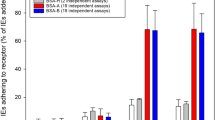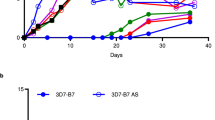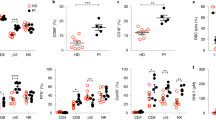Abstract
The malaria parasite Plasmodium falciparum is one of the most successful human pathogens. Specific virulence factors remain poorly defined, although the adhesion of infected erythrocytes tothe venular endothelium has been associated with some of thesyndromes of severe disease1. Immune responses cannot prevent the development of symptomatic infections throughout life, and clinical immunity to the disease develops only slowly during childhood. An understanding of the obstacles to the development of protective immunity is crucial for developing rational approaches to prevent the disease. Here we show that intact malaria-infected erythrocytes adhere to dendritic cells, inhibit the maturation of dendritic cells and subsequently reduce their capacity to stimulate T cells. These data demonstrate both a novel mechanism by which malaria parasites induce immune dysregulation and a functional role beyond endothelial adhesion for the adhesive phenotypes expressed at the surface of infected erythrocytes.
This is a preview of subscription content, access via your institution
Access options
Subscribe to this journal
Receive 51 print issues and online access
$199.00 per year
only $3.90 per issue
Buy this article
- Purchase on Springer Link
- Instant access to full article PDF
Prices may be subject to local taxes which are calculated during checkout





Similar content being viewed by others
References
MacPherson, G. G., Warrell, M. J., White, N. J., Looareesuwan, S. & Warrell, D. A. Human cerebral malaria. A quantitative ultrastructural analysis of parasitized erythrocyte sequestration. Am. J. Pathol. 119, 385–401 (1985).
Hill, A. V. et al . Molecular analysis of the association of HLA-B53 and resistance to severe malaria. Nature 360, 434–439 (1992).
Marsh, K. et al . Antibodies to blood stage antigens of Plasmodium falciparum in rural Gambians and their relation to protection against infection. Trans. R. Soc. Trop. Med. Hyg. 83, 293–303 (1989).
Brown, K. N. Antigenic diversity, antigenic variation and merozoite surface protein 1. Parassitologia 35, Suppl., 13–15 (1993).
Roberts, D. J. et al . Rapid switching to multiple and adhesive phenotypes in malaria. Nature 357, 689–692 (1992).
Gilbert, S. C. et al . Association of malaria parasite population structure, HLA, and immunological antagonism. Science 279, 1173–1177 (1998).
Banchereau, J. & Steinman, R. M. Dendritic cells and the control of immunity. Nature 392, 245–252 (1998).
Austyn, J. M. Dendritic cells. Curr. Opin. Hematol. 5, 3–15 (1998).
Sallusto, S., Cella, M., Danieli, C. & Lanzavecchia, A. Dendritic cells use macropinocytosis and the mannose receptor to concentrate macromolecules in the major histocompatibility complex class II compartment: downregulation by cytokines and bacterial products. J. Exp. Med. 182, 389–400 (1995).
Smith, J. D. et al . Switches in expression of Plasmodium falciparum var genes correlate with changes in antigenic and cytoadherent phenotypes of infected erythrocytes. Cell 82, 101–110 (1995).
Roberts, D. D. et al . Thrombospondin binds falciparum malaria parasitized erythrocytes and may mediate cytoadherence. Nature 318, 64–66 (1985).
Barnwell, J. W. et al . Ahuman 88-kD membrane glycoprotein (CD36) functions in vitro as a receptor for a cytoadherence ligand on Plasmodium falciparum-infected erythrocytes. J. Clin. Invest. 84, 765–772 (1989).
Berendt, A. R. et al . The binding site on ICAM-1 for Plasmodium falciparum-infected erythrocytes overlaps, but is distinct from, the LFA-1-binding site. Cell 68, 71–81 (1992).
Coppel, R. L., Cooke, B. M., Magowan, C. & Narla, M. Malaria and the erythrocyte. Curr. Opin. Hematol. 5, 132–138 (1998).
Zhou, L. J. & Tedder, T. F. Human blood dendritic cells selectively express CD83, a member of the immunoglobulin superfamily. J. Immunol. 154, 3821–3835 (1995).
Gardner, J. P., Pinches, R. A., Roberts, D. J. & Newbold, C. I. Variant antigens and endothelial receptor adhesion in Plasmodium falciparum. Proc. Natl Acad. Sci. USA 93, 3503–3508 (1996).
Udeinya, I. J., Schmidt, J. A., Aikawa, M., Miller, L. H. & Green, I. Falciparum malaria-infected erythrocytes specifically bind to cultured human endothelial cells. Science 213, 555–557 (1981).
Plebanski, M., Saunders, M., Burtles, S. S., Crowe, S. & Hooper, D. C. Primary and secondary human in vitro T cell responses to soluble antigens are mediated by subsets bearing different CD45 isoforms. Immunology 75, 86–90 (1992).
Nagvekar, N. et al . Apathogenic role for the thymoma in myasthenia gravis. Autosensitization of IL-4-producing T-cell clones recognizing extracellular acetylcholine receptor epitopes presented by minority class II isotyes. J. Clin. Invest. 101, 2268–2277 (1998).
Williamson, B. A. & Greenwood, B. M. Impairment of the immune response to vaccination after acute malaria. Lancet 1, 1328–1329 (1978).
Greenwood, B. M., Bradley, A. K., Blakebrough, I. S. & Whittle, H. C. The immune response to a meningococcal polysaccharide vaccine in an African village. Trans. R. Soc. Trop. Med. Hyg. 74, 340–346 (1980).
Walsh, D. S., Looareessuwan, S., Vaninangonata, S., Virvan, C. & Webster, H. K. Cutaneous delayed-type hypersensitivity responsiveness in patients during and after Plasmodium falciparum and Plasmodium vivax infections. Clin. Immunol. Immunopathol. 77, 89–94 (1995).
Newbold, C. et al . Receptor-specific adhesion and clinical disease in Plasmodium falciparum. Am. J. Trop. Med. Hyg. 57, 389–398 (1997).
Howard, R. W. & Barnwell, J. W. Role of surface antigens on malaria-infected red blood cells in evasion of immunity. Contemp. Top. Immunobiol. 12, 127–200 (1984).
Langreth, G. E. & Peterson, E. Pathogenicity, stability, and immunogenicity of a knobless clone of Plasmodium falciparum in Colombian owl monkeys. Infect. Immun. 47, 760–766 (1985).
Gilks, C. F., Walliker, D. & Newbold, C. I. Relationships between sequestration, antigenic variation and chronic parasitism in Plasmodium chabaudi chabaudi—a rodent malaria model. Parasite Immunol. 12, 45–64 (1990).
Howard, R. J., Barnwell, J. W. & Kao, V. Antigenic variation of Plasmodium knowlesi malaria: identification of the variant antigen on infected erythrocytes. Proc. Natl Acad. Sci. USA 80, 4129–4133 (1983).
Udomsanpetch, R., Thanikkul, K., Pukrittayakamee, S. & White, N. J. Rosette formation by Plasmodium vivax. Trans. R. Soc. Trop. Med. Hyg. 89, 635–637 (1995).
Trager, W. & Jensen, J. B. Human malaria parasites in continuous culture. Science 193, 673–675 (1976).
Schwarzer, E., Turrini, F. & Arese, P. Aluminescence method for the quantitative determination of phagocytosis of erythrocytes, of malaria-parasitized erythrocytes and of malarial pigment. Br. J. Haematol. 88, 740–745 (1994).
Acknowledgements
We thank T. F. Tedder for the gift of anti-CD83 monoclonal antibody, D. Chao, P.Bahl, L. Corlett and K. Pulford for technical advice and C. Newbold, A. Vincent, B. C. Elford and S.Roberts for support and encouragement. D.J.P.F. was supported by the Wellcome Trust. D.J.R. is a Wellcome Trust Senior Fellow in Clinical Science and B.C.U. was supported by a Fellowship from the Deutsche Forschungsgemeinschaft.
Author information
Authors and Affiliations
Corresponding author
Rights and permissions
About this article
Cite this article
Urban, B., Ferguson, D., Pain, A. et al. Plasmodium falciparum-infected erythrocytes modulate the maturation of dendritic cells. Nature 400, 73–77 (1999). https://doi.org/10.1038/21900
Received:
Accepted:
Issue Date:
DOI: https://doi.org/10.1038/21900
This article is cited by
-
Host susceptibility genes of asymptomatic malaria from South Central Timor, Eastern Indonesia
Parasitology Research (2023)
-
Dendritic cell responses to Plasmodium falciparum in a malaria-endemic setting
Malaria Journal (2021)
-
Plasmodium yoelii 17XL infection modified maturation and function of dendritic cells by skewing Tregs and amplificating Th17
BMC Infectious Diseases (2020)
-
Splenic findings in patients with acute babesiosis
Abdominal Radiology (2020)
-
TREM-1 modulation produces positive outcome on the histopathology and cytokines release profile of Plasmodium berghei-infected mice
Journal of Parasitic Diseases (2019)
Comments
By submitting a comment you agree to abide by our Terms and Community Guidelines. If you find something abusive or that does not comply with our terms or guidelines please flag it as inappropriate.



